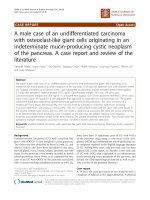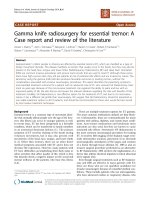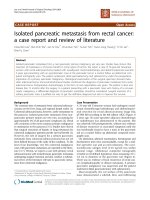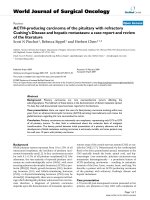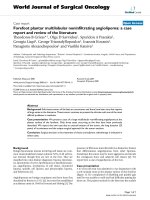Báo cáo y học: " Spontaneous heterotopic pregnancy with tubal rupture: a case report and review of the literature" pptx
Bạn đang xem bản rút gọn của tài liệu. Xem và tải ngay bản đầy đủ của tài liệu tại đây (174.82 KB, 3 trang )
Case report
Open Access
Spontaneous heterotopic pregnancy with tubal rupture:
a case report and review of the literature
Rimpy Tandon*, Poonam Goel, Pradip Kumar Saha and Lajya Devi
Address: Department of Obstetrics & Gynecology and Pathology, Government Medical College & Hospital, Sector 32-B, Chandigarh-160 030, India
Email: RT* - ; PG - ; PKS - ; LD -
* Corresponding author
Received: 19 March 2008 Accepted: 22 January 2009 Published: 10 June 2009
Journal of Medical Case Reports 2009, 3:8153 doi: 10.4076/1752-1947-3-8153
This article is available from: />© 2009 Tandon et al; licensee Cases Network Ltd.
This is an Open Access article distributed under the terms of the Creative Commons Attribution License (
/>which permits unrestricted use, distribution, and reproduction in any medium, provided the original work is properly cited.
Abstract
Introduction: Heterotopic pregnancy is diagnosed as the presence of two gestations simulta-
neously. This is a rare situation with a reported prevalence of 0.08% in normal conception.
Case presentation: We report a case of a 24-year-old primigravida of Indian origin who was seen
in the emergency department with a diagnosis of a ruptured ectopic pregnancy. A careful ultrasound
assessment led to the diagnosis of a heterotopic pregnancy. Immediate surgical intervention with
supportive measures resulted in a successful outcome.
Conclusion: An obstetrician should keep in mind the occurrence of a heterotopic pregnancy while
dealing with pregnant females. The ectopic gestation invariably ruptures over a period of time leaving
the patient in an emergency situation. A quick assessment and careful handling of the normal gestation
can lead the patient to term with gratifying results.
Introduction
Heterotopic pregnancy (HP) is diagnosed in the presence
of simultaneous gestations at two or more implantation
sites. It was first reported in the year 1708 as an autopsy
finding [1]. Its occurrence is rare in spontaneous concep-
tion with an incidence of 1:30,000 [1], while in assisted
reproductive techniques (ART), the incidence is found to
be as high as 1% [1]. We report a case of HP in a natural
conception cycle that presented with tubal rupture.
Case presentation
A 24-year-old primigravid woman of Indian origin and
married for one year was seen in our emergency
department with a history of a brief episode of loss of
consciousness and acute pain in her abdomen of four
hours duration. She was 8 weeks pregnant. It was a
spontaneous conception and there was no past history of
abortion, infertility, pelvic inflammatory disease or any
history of abdominal surgery. On examination, she was
pale with a pulse rate of 120 per minute and blood
pressure of 80/60 mmHg. Abdominal examination
revealed diffuse, lower abdominal tenderness with sig-
nificant guarding and rigidity. Pelvic examination revealed
an anteverted, enlarged, soft and tender uterus correspond-
ing to 8 weeks of pregnancy. In addition, a tender mass
was also palpable in her right adnexa. Cervical movements
were painful but there was no bleeding. After initial
resuscitation with intravenous fluids, she was further
Page 1 of 3
(page number not for citation purposes)
investigated. Her hemoglobin was 4.2 gm/dl with a
normal white blood count (WBC) and platelet count.
Urine for HCG (human chorionic gonadotropin) was
positive. Transvaginal sonography revealed an 8-week
intrauterine viable pregnancy and a 3.3 x 2.2 cm echogenic
mass near her right ovary with a 1.6 x 1.0 cm central
anechoic area. A moderate amount of fluid was present in
the cul-de-sac and in Morrison’s space and a diagnosis of
heterotopic pregnancy with tubal rupture was made. An
emergency laparotomy on the patient revealed an 8-week
gravid uterus and rupture of the right tube near the
fimbrial end and the presence of approximately 1.5 liters
of hemoperitoneum. Right salpingectomy with removal of
the hemoperitoneum and peritoneal lavage was per-
formed. She was transfused with four units of blood
during and after the surgery and her postoperative period
was uneventful. Histopathology of the resected specimen
showed the presence of chorionic villi confirming a viable
pregnancy. The patient was discharged and followed-up
regularly in the antenatal clinic. At 38 weeks gestation she
went into spontaneous labor and delivered a healthy male
baby weighing 2.6 kg with no congenital malformation.
Postnatal recovery was uneventful and both mother and
baby were discharged on the third postpartum day.
Discussion
HP is diagnosed in the presence of multiple pregnancies
with one or more intrauterine pregnancies co-existing with
an ectopic pregnancy. The ectopic pregnancy can be tubal,
ovarian, cervical, cornual or abdominal. Tubal ectopic
pregnancies are the most common. The occurrence of a
heterotopic pregnancy is considered rare in natural concep-
tion cycles with an incidence of 0.08%, but incidence
increases to as high as 1% with assisted reproductive
techniques [1]. This is because of transfer of embryos by ART
techniques into affected tubes and peristaltic movements do
not expel these embryos. The common factors that
predispose to occurrence of ectopic pregnancy are tubal
surgery and pelvic inflammatory diseases [1,3].
Early diagnosis of HP is often difficult because of the
absence of clinical symptoms. Reece et al [1] defined
abdominal pain, adnexal mass, peritoneal irritation and
an enlarged uterus as signs and symptoms suspicious of
HP. Transvaginal ultrasound and assessment of the whole
pelvis, even in the presence of intrauterine pregnancy, can
be an important aid in the diagnosis of HP [1]. Further,
visualization of heart activity in both intrauterine and
extrauterine gestation confirms the diagnosis of HP [1].
The advent of ultrasound (USG) has not changed
diagnostic ability over a period of time. In a review of
the literature of all cases of HP from 1971 to 1993, out of
112 cases, 46 were diagnosed by USG while 66 were
diagnosed at laparoscopy or laparotomy. The recent
literature review from 1994 to 2004 also showed that
out of 80 cases, 21 were diagnosed by USG and 59 at
laparoscopy or laparotomy [1]. One of the reasons for this
unexpected observation is that HP is a rare condition and
most patients with HP present in the emergency depart-
ment with symptoms of a rupture of ectopic component.
Thus, a preoperative diagnosis of HP is still a challenge.
Serial b-HCG levels are not of much significance in the
diagnosis of HP as subnormal hormone production by an
ectopic pregnancy may be masked by the higher placental
production from the intrauterine pregnancy. Culdocent-
esis is an important aid in diagnosis when hemoperito-
neum is present [1] as echogenic pelvic fluid is more
important than anechoic fluid because it indicates the
presence of peritoneal hemorrhage.
The standard treatment for ectopic pregnancy is surgery by
laparoscopy or laparotomy depending upon the condition
of the patient. The main aim of the surgery should be the
preservation of the intrauterine pregnancy with minimal
manipulation of the uterus. Medical treatment for ectopic
pregnancy with an intact tube is a local injection of
potassium chloride. Fertility results have been found to be
the same after laparoscopy or laparotomy. Conservative or
radical surgery may be done depending upon the condition
of the contralateral tube; a review by Clausen I [1]
demonstrated no difference in rates of IUP after conserva-
tive or radical surgery. The prognosis of IUP is favorable in
60 to 70% of cases; Smith and Siddique reported a survival
rate between 35% and 54% in 1971 [1]. In the study by
Tal et al [1] 66% proceeded to full term while in the study
by Barrenetxea et al, 69% proceeded to full term [1]. The
improvement in IUP survival rate is probably due to better
diagnostic and treatment developments and close follow-
up of patients after ART techniques.
Conclusion
Heterotopic pregnancy can occur in the absence of any
predisposing risk factors, and the detection of an
intrauterine pregnancy does not exclude the possibility
of the simultaneous existence of an ectopic pregnancy.
Hence, in all patients of reproductive age, even in the
presence of an intrauterine pregnancy, a complete review
of the whole pelvis including adnexa should be done at
the time of ultrasound to rule out the presence of a
heterotopic pregnancy.
Abbreviations
HP, heterotopic pregnancy; ART, assisted reproductive
techniques; USG, ultrasound; IUP, intrauterine pregnancy.
Consent
Written informed consent was obtained from the patient
for publication of this case report. A copy of the written
Page 2 of 3
(page number not for citation purposes)
Journal of Medical Case Reports 2009, 3:8153 />consent is available for review by the Editor-in-Chief of
this journal.
Competing interests
The author(s) declare that they have no competing
interests.
Authors’ contributions
RT was involved in the patient management and wrote the
paper. PG and PKS were involved in the patient manage-
ment. LD was involved in the follow-up of the patient. All
authors read and approved the final manuscript.
References
1. Bright DA, Craupp FB: Heterotopic pregnancy: a re-evaluation.
J Am Board Fam Pract 1990, 3:125-128.
2. Ludwig M, Kaisi M, Bauer O, Diedrich K: Heterotopic pregnancy
in a spontaneous cycle. Cur J Obstet Gynecol Reprod Biol 1999,
87:91-103.
3. Tal J, Hadded S, Gordon N, Timor-Tritsch I: Heterotopic
pregnancy after ovulation induction and assisted reproduc-
tive technologies: a literature review from 1971 - 1993. Fertil
Steril 1996, 66:1-12.
4. Reece EA, Petrie RH, Sirmans MF, Finster M, Todd WD: Combined
intrauterine and extrauterine gestations: a review. Am J Obstet
Gynecol 1983, 146:323-330.
5. Anjum WM, Van der Veen F, Hamerlynck JVThH, Lammes FB:
Transvaginal sonography and human chorionic gonadotro-
phin measurments in suspected ectopic pregnancy: a detailed
analysis of a diagnostic approach. Hum Reprod 1993,
8:1307-1311.
6. Cheng PJ, Chueh HY, Qiu JT: Heterotopic pregnancy in a natural
conception cycle presenting as hematometra. Obstet Gynecol
2004, 104(Suppl):1195-1198.
7. Barrenetxea G, Barinaga- Rementeria L, de Larruzea AL,
Agirregoikoa JA, Mandiola M, Carbonero K: Heterotopic preg-
nancy: two cases and a comparative review. Fertil Steril 2007,
87:417 e9-e15.
8. Wang P-H, Chao H-T, Tseng J-Y, Yang T-S, Chang S-P, Yuan C-C,
Ng HT: Laparoscopic surgery for heterotopic pregnancies: a
case report and a brief review. Eur J Obstet Gynecol Reprod Biol
1998, 80:267-271.
9. Clausen I: Conservative versus radical surgery for tubal
pregnancy: a review. Acta Obstet Gynecol Scand 1996, 75:8-12.
10. Smith DJH, Siddique FH: A case of heterotopic pregnancy. Am J
Obstet Gynecol 1970, 108:1289-1290.
Page 3 of 3
(page number not for citation purposes)
Journal of Medical Case Reports 2009, 3:8153 />Do you have a case to share?
Submit your case report today
• Rapid peer review
• Fast publication
• PubMed indexing
• Inclusion in Cases Database
Any patient, any case, can teach us
something
www.casesnetwork.com

